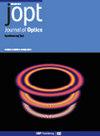Magnetic field enhanced terahertz generation from shape-dependent metallic nanoparticles
IF 2.7
4区 物理与天体物理
Q3 OPTICS
引用次数: 0
Abstract
This communication deals with the analytical study of terahertz (THz) generation via frequency-difference mechanism using two circularly symmetric Gaussian laser beams with slightly different frequencies and and wave vectors and simultaneously propagating through a mixture of spatially corrugated noble-metal nanoparticles. The mixture, consisting of spherical nanoparticles (SNPs) and cylindrical nanoparticles (CNPs), is placed in a host medium under the influence of an externally applied static magnetic field. The two co-propagating laser beams impart a nonlinear ponderomotive force on the electrons of the NPs, causing them to experience nonlinear oscillatory velocity. Furthermore, the consequent nonlinear current density excites THz radiation at the beat frequency . Magnetic fields influence the surface plasmon resonance condition associated with electrons of the nanoparticles due to enhancement in ponderomotive nonlinearities, thereby causing an increment in the amplitude of the generated THz field. It is observed that the generated THz radiation has a strong dependence on the shape and size of the NPs in addition to the magnetic field strength. CNPSs provide greater THz amplitude than SNPs due to additional resonance modes, and combining both kinds of nanostructures further enhances the amplitude. THz radiation plays an important role in biomedical and pharmaceutical fields, communications, security and THz spectroscopy.形状依赖性金属纳米粒子的磁场增强型太赫兹产生
这篇论文涉及通过频差机制对太赫兹(THz)产生的分析研究,使用两束频率和波矢量略有不同的圆形对称高斯激光束,同时通过空间波纹贵金属纳米粒子混合物传播。该混合物由球形纳米粒子(SNPs)和圆柱形纳米粒子(CNPs)组成,置于外部静磁场影响下的主介质中。两束共同传播的激光对 NPs 的电子产生非线性思索动力,使其产生非线性振荡速度。此外,随之而来的非线性电流密度激发了拍频的太赫兹辐射。由于思索非线性的增强,磁场会影响与纳米粒子电子相关的表面等离子体共振条件,从而导致产生的太赫兹场振幅增大。据观察,除磁场强度外,所产生的太赫兹辐射还与纳米粒子的形状和尺寸密切相关。与 SNP 相比,CNPS 因具有额外的共振模式而可提供更大的太赫兹振幅,而将这两种纳米结构结合在一起可进一步增强振幅。太赫兹辐射在生物医学和制药、通信、安全和太赫兹光谱学领域发挥着重要作用。
本文章由计算机程序翻译,如有差异,请以英文原文为准。
求助全文
约1分钟内获得全文
求助全文
来源期刊

Journal of Optics
OPTICS-
CiteScore
4.50
自引率
4.80%
发文量
237
审稿时长
1.9 months
期刊介绍:
Journal of Optics publishes new experimental and theoretical research across all areas of pure and applied optics, both modern and classical. Research areas are categorised as:
Nanophotonics and plasmonics
Metamaterials and structured photonic materials
Quantum photonics
Biophotonics
Light-matter interactions
Nonlinear and ultrafast optics
Propagation, diffraction and scattering
Optical communication
Integrated optics
Photovoltaics and energy harvesting
We discourage incremental advances, purely numerical simulations without any validation, or research without a strong optics advance, e.g. computer algorithms applied to optical and imaging processes, equipment designs or material fabrication.
 求助内容:
求助内容: 应助结果提醒方式:
应助结果提醒方式:


